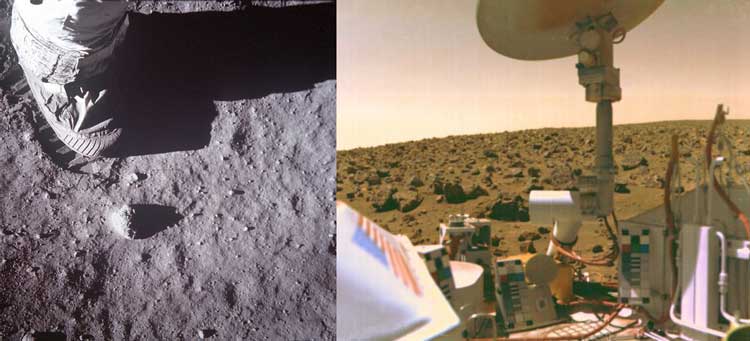Thursday Topsight, July 20, 2006

Viking is not alone with this anniversary. 37 years ago today, human beings first set foot on the Moon. While Michael Collins orbited overhead, Neil Armstrong and Edwin Aldrin stepped from a landing vehicle (with walls no thicker than aluminum foil) onto the surface of another world; their footsteps will remain there for eons, proof that Earth once held a civilization able to reach beyond its home. It was an achievement that was, in the end, ahead of its time. The Apollo program was too big, too expensive, too wrapped up in Cold War competition to be sustainable as the catalyst for expanding human civilization off of one planet. Not that it was the wrong choice, but our expectations were perhaps too great for Apollo's potential. Sometimes, symbols are enough.
• Lightning Unleashed: Tesla Motors has unveiled its new all-electric sports car. If you've hit a green or gadget site, you've probably seen the particulars: 250 mile range; top speed of 130 mph; redline at 13,500 rpm; 0-60 in 4 seconds; double the energy efficiency of a Prius; and a price tag of $80K-$100K. On the one hand, it's a nice symbol of the potential power of electric vehicles -- this isn't a souped-up golf cart. On the other, it's a foreshadowing of the potential transfiguration of the automobile industry.
Ford, GM, BMW, Toyota -- traditional car-makers attained their current prominence by perfecting the increasingly complex internal combustion engine. By comparison, electric cars are incredibly simple, and the organizational capacities needed to make them viable have as much to do with the computer and electronics industry as they do with the traditional automotive industry. The idea of Apple, Sony or even Microsoft making an internal combustion engine car would be laughable, but the idea of those same companies working on the design of electric vehicles is much more plausible. They'd likely collaborate with automobile manufacturers at first -- but likely not the traditional big car-makers. Imagine an electric car designed by Apple, built by various suppliers in Korea and Taiwan, and drop-shipped to your driveway by Amazon.
• Google Earth At War: Want some photos of secret North Korean military facilities? Got Google Earth? Get 'em yourself, then.
Open Source Radio reports that, because the North Korean government doesn't actually speak to anybody on a regular basis, Google/Keyhole hasn't ever been asked to dial-back the resolution of certain areas (as they've supposedly done at the request of other governments). As a result, it's possible to find a variety of military installations that Pyongyang might not want you to see.
A less ominous version of Google Earth at war (at least, possibly less ominous) is "Google Earth Battleship:"
University of Southern California's Julian Bleecker has a very interesting summer project going: Playing Battleships using Google Earth as a game board, but with the twist that you have to physically visit the location on the board you want to attack, using your mobile phone to "call in" a strike. [...] Julian has an interesting notion to describe this kind of gaming: It's a "1st Life/2nd Life mashup", in that real-world actions impact the state of a virtual world.
Kinda spooky putting those two together, no? There's a SciFi Channel movie of the week just writing itself right here.
• Seeing Spots: HP has announced the development of "memory spots," a form of radio frequency ID tag that includes significantly more computational capacity than traditional RFID units.
The chip has a 10 megabits-per-second data transfer rate – 10 times faster than Bluetooth™ wireless technology and comparable to Wi-Fi speeds – effectively giving users instant retrieval of information in audio, video, photo or document form. With a storage capacity ranging from 256 kilobits to 4 megabits in working prototypes, it could store a very short video clip, several images or dozens of pages of text. Future versions could have larger capacities.Information can be accessed by a read-write device that could be incorporated into a cell phone, PDA, camera, printer or other implement.
Standard RFID is essentially a form of barcode on steroids -- a passive information instrument, readable at a distance. The memory spot is really an entirely different beast, despite superficial similarities. As readable-writable CMOS devices, they are arguably much closer to smart digital cameras. The potential uses are pretty amazing. This kind of device (no larger than a grain of rice), for example, could easily be embedded in any number of material products, providing detailed information about both the capabilities of the product and its current status -- a built-in self-updating instruction manual. Or how about Stuart Candy's "ambient foresight" project with these devices instead of pre-downloaded MP3s?





